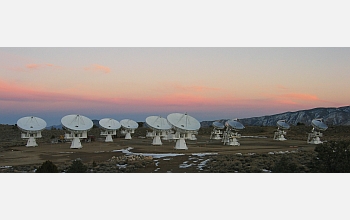|

Press Release 06-078
Astronomers Dedicate CARMA Telescope Array

May 5, 2006
On Friday, May 5, astronomers will dedicate a millimeter-wave telescope array that will serve as the most powerful instrument of its type for years to come.
The Combined Array for Research in Millimeter-Wave Astronomy (CARMA), a joint venture of the California Institute of Technology, the University of California at Berkeley, the University of Maryland and the University of Illinois, was created by moving the six 10-meter telescopes at Caltech's Owens Valley Radio Observatory, along with nine 6-meter telescopes at the Berkeley-Illinois-Maryland Association array, to a new location at Cedar Flat in the Inyo Mountains near Bishop, Calif.
The National Science Foundation (NSF) has supported both the earlier arrays since their inception, and will continue to support CARMA operations.
CARMA's new location in the dry desert air of Cedar Flat, whose 7,200-foot elevation is more than twice that of either previous site, will give the combined 15-telescope array unparalleled sensitivity. Indeed, the array will produce millimeter-wave images comparable in resolution to the Hubble Space Telescope's optical images.
"CARMA will do great science in a lot of different areas," says Richard Barvainis, the NSF program officer in charge of the project. Its targets will include cold molecular gas that fuels star formation and feeds massive black holes; disks of gas and dust that may one day give rise to planets around newly forming stars; interstellar clouds that can form the molecular building blocks of life; and fluctuations in the cosmic microwave background radiation that provide clues to the origin and early evolution of the universe.
Perhaps just as important, adds Barvainis, "CARMA will serve as the pathfinder for ALMA"--the Atacama Large Millimeter Array that is now being built in the Chilean Andes with funding from NSF, Canada, Japan, Europe and Chile. When ALMA is completed in 2012, it will have a resolution ten times better than Hubble's.
For more information about CARMA, visit http://www.mmarray.org/.
For more information about ALMA, visit http://www.alma.nrao.edu/.
-NSF-

Media Contacts
M. Mitchell Waldrop, NSF (703) 292-7752 mwaldrop@nsf.gov
Related Websites
The CARMA Web site: http://www.mmarray.org
The ALMA Web site: http://www.alma.nrao.edu/

The National Science Foundation (NSF) is an independent federal agency that supports fundamental research and education across all fields of science and engineering. In fiscal year (FY) 2009, its budget is $9.5 billion, which includes $3.0 billion provided through the American Recovery and Reinvestment Act. NSF funds reach all 50 states through grants to over 1,900 universities and institutions. Each year, NSF receives about 44,400 competitive requests for funding, and makes over 11,500 new funding awards. NSF also awards over $400 million in professional and service contracts yearly.
 Get News Updates by Email Get News Updates by Email
Useful NSF Web Sites:
NSF Home Page: http://www.nsf.gov
NSF News: http://www.nsf.gov/news/
For the News Media: http://www.nsf.gov/news/newsroom.jsp
Science and Engineering Statistics: http://www.nsf.gov/statistics/
Awards Searches: http://www.nsf.gov/awardsearch/
| 

